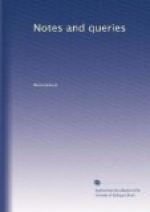OXONIENSIS.
[Bishop Ken’s Morning and Evening Hymns have been restored in Messrs. Eyre and Spottiswoode’s last rubricated edition of the Common Prayer, as far as was practicable; they were carefully collated with the original, and all variations corrected, except those which would materially affect immemorial use. The entire hymns are of great length, but all those verses which have been at all generally sung in churches are to be found in the edition to which we refer.
We may take this opportunity of noticing that the Queen’s printers have lately restored the lesser Saints’ Days to the kalendar in their smaller editions of the Common Prayer. We are not aware of any other similar editions in which the kalendar appears thus complete.]
Etymology of “Daysman.”—What is the etymology of Daysman, which, in the Book of Job, and in some of our provincial dialects, means a mediator or arbitrator?
MARK ANTONY LOWER.
[NARES defines Daysman, an umpire or arbitrator, from his fixing a day for decision; and adds, “Mr. Todd shows that day sometimes meant Judgment.” Jacob, in his Law Dictionary, tells us, “Days-man signifies, in the North of England, an arbitrator or person chosen to determine an affair in dispute, who is called a Dies-man or Days-man.” Jacob’s definition may be again illustrated from NARES:—“In Switzerland (as we are informed by Simlerus) they had some common arbitrators, or dayesmen, in every towne, that made a friendly composition betwixt man and man.”—Burton, Anat.]
Roland Monoux.—In answer to your correspondent “M”, p. 137., the monumental brass in his possession is, no doubt, from the church at Edmonton, Middlesex. Lysons (Environs of London, vol. ii. p. 263.), in his description of Edmonton Church, says, “Near the door is a brass plate, with some English verses to the memory of ROLAND MONOUX (no date).” He subjoins, in a note, “arms—on a chevron betw. 3 oak-leaves as many bezants, on a chief 2 anchors, a market for difference. On the brass plate are some English verses, nowise remarkable.”
These arms (omitting the chief) are those borne by the Baronet Monnoux of Sandy in Bedfordshire (extinct in 1814), who was descended from Sir George Monox, of Walthamstow, Lord Mayor of London, who died in 1543, to whom and his lady there are brasses in Walthamstow Church. ROLAND of Edmonton was doubtless of the same family. I am not able to give an opinion of the date of the brass in question; but it might be readily conjected from the style of its execution.
Your readers will, I am sure, all unite with me in commendation of your correspondent “M’s” correct feeling in offering to restore this monument to its original site. I hope “M’s” example will find many followers. There are hundreds of {189} these pillaged brasses in the hands of “collectors,” and your admirable publication will have effected a great public good, if it shall have been instrumental in promoting their restoration.




